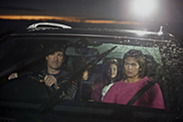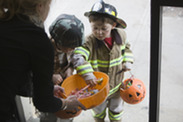|
Safety and Health Information for Wisconsin Employers & Organizations |
|
|
As we move into the latter stages of Autumn, time and temperatures begins to change, as does our mindset with the approaching Holiday season. Check out the seasonal family and personal safety tips being offered by the National Safety Council (NSC).
The first Sunday in November is when Daylight Saving Time ends in most U.S. areas of the U.S. when we "Fall Back" one hour returning to Standard Time Sunday, Nov. 5, 2023, at 2 a.m. Be sure to set your clocks back one hour before bedtime on Saturday, Nov. 4.
The return to Standard Time poses additional seasonal challenges for drivers, including:
|
|

- Shorter daylight days;
- Fatigue;
- Compromised night vision;
- Rush hour traffic;
- Impaired fellow drivers.
These are only some of the risks drivers face. Per NSC analysis, federal statistics reveal these risks become especially pronounced moving into the weekend, with fatal crashes peaking on Saturday nights.
The number of nonfatal crashes tend to be higher on weekdays, peaking Fridays. For both fatal and nonfatal crashes, the peak time of day was 4 to 7:59 p.m., but peak crash periods vary substantially over the span of a year:
- During the spring and summer months, fatal crashes tended to peak between 8 and 11:59 p.m.
- In contrast, the nonfatal crash peak is earlier in the summer, from noon to 3:59 p.m.
- From November through March, the peak for fatal crashes was from 4 to 7:59 p.m.
|
|
|

Thanksgiving weekend will see millions on our nation's roads, eager to spend time with friends and family. It’s one of the busiest travel times of the year, and unfortunately more people on the road means the potential for more vehicle crashes.
During holidays, traffic deaths increase an estimated 30%. With an annual average of over 500 car accident fatalities, Thanksgiving is the most dangerous holiday to be on the roadways.
Visit the Traffic Safety Marketing web site for safe driving campaigns and resources Nov. 22 to 26, 2023.
|
Even though National Fire Protection Association (NFPA) and NSC's October Fire Safety Week/Month events are over, don't let your home fire safety guard down. The holidays often include increased use of kitchens, space heaters and fireplaces, which means increased fire dangers. Read more about kitchen fires, cooking and food prep safety at NFPA-Seasonal Fire Safety/Thanksgiving.
Also, while very popular, be wary of Thanksgiving turkey deep frying hazards, especially with respect to avoiding structures such as garages. Due to their high risk, the NFPA strongly discourages the use of turkey fryers! For more tips and information on safe cooking view the video linked below.
Cooler weather means Flu season is upon us. The effect of flu can vary substantially from one year to another, but the Centers for Disease Control and Prevention (CDC) estimates that between 2010 and 2020, the common flu resulted in as many as 41 million illnesses, 710,000 hospitalizations, and 52,000 deaths annually.
Individuals younger than 5 and over 65 years old are at increased risk. The CDC recommends everyone older than 6 months get the annual flu vaccine as soon as it becomes available. October and November are the ideal months to get your seasonal flu shot/flu vaccine, but the best time is anytime you can.
Additionally the CDC recommends staying up to date with COVID-19 Vaccines to avoid the potential effects of compound infections.
|
|

With Halloween behind us and the holiday season approaching, kids will have many opportunities to indulge in holiday candies and treats. Parents should diligently supervise their kids' candy and sweets intake and ration treats following Halloween.
Inspect their candy throw away any that looks like it has been opened or altered. Also, depending on your specific child's needs and development, remember to review candy for possible allergens or choking hazards.
Click below for additional kids candy safety tips and to learn more about parental roles for enjoying safe sweets and treats this holiday season.
|
|
|

Prevent Blindness declared November as Diabetes-related Eye Disease Month to provide the public with a variety of helpful tools to prevent unnecessary vision loss from diabetes.
Diabetic retinopathy (DR) is a common complication of diabetes and according to the CDC is the leading cause of blindness in American adults. It is characterized by progressive damage to the blood vessels of the retina, the light-sensitive tissue at the back of the eye that is necessary for good vision. An estimated 4.1 million Americans are actively affected by retinopathy, with another 899,000 facing retinopathy threats to their vision.
Prevent Blindness has a Diabetes & the Eyes Educational Toolkit available in English and Spanish, which includes educational resources. Resources include the Diabetes-related Eye Disease and Mental Health fact sheet and a video series which includes Diabetes, Vision Loss, and Mental Wellness. These resources are intended for healthcare professionals, community health educators, and those in a caregiving or diabetes education role.
|
As we enter the post-Thanksgiving part of the holiday season, be alert to the approach of inclement weather and related safety hazards. More to follow as we enter the busy December holiday season and the onset of Wisconsin's winter months.
Have a Safe Day, Always!!
|
|

Dave Leix is a Certified Safety Professional (CSP) and Safety & Risk Manager for the State of Wisconsin / Department of Workforce Development (DWD) – Worker's Compensation Division. Dave brings over 40 years of professional safety and health (EHS) consulting and managerial experience to a wide variety of customers and clients. Read more about Dave online.
|
|
|
|
|
|